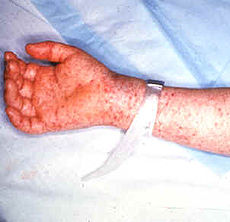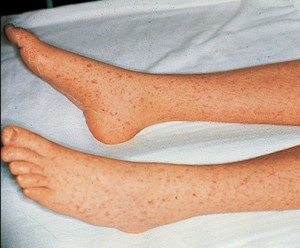Are you suffering from fever, muscular pain and small rashes in ankles and wrists? Watch out, for these are the classic signs of a bacterial disorder known as Rocky Mountain spotted fever (RMSF). Read and know all about this disorder, including its various causes, symptoms, diagnosis and treatment options.
Rocky Mountain spotted fever Definition
Page Contents
- 1 Rocky Mountain spotted fever Definition
- 2 Rocky Mountain spotted fever ICD9 Code
- 3 Rocky Mountain spotted fever Incidence
- 4 Rocky Mountain spotted fever Symptoms
- 5 Rocky Mountain spotted fever Causes
- 6 Rocky Mountain spotted fever Risk Factors
- 7 Rocky Mountain spotted fever Diagnosis
- 8 Rocky Mountain spotted fever Differential Diagnosis
- 9 Rocky Mountain spotted fever Treatment
- 10 Rocky Mountain spotted fever Prognosis
- 11 Rocky Mountain spotted fever Mortality Rate
- 12 Rocky Mountain spotted fever Recovery Time
- 13 Rocky Mountain spotted fever Complications
- 14 Rocky Mountain spotted fever Prevention
- 15 Rocky Mountain spotted fever in Dogs
- 16 Is Rocky Mountain spotted fever Contagious?
- 17 Rocky Mountain spotted fever Pictures
It is a disorder caused by a type of bacteria referred to as Ticks. The condition most frequently arises in summer and spring, particularly between early-April and early-September, when ticks are most active.
The disorder is also known by another name – Spotted fever.
Rocky Mountain spotted fever ICD9 Code
The ICD9 Code for this disorder is 082.0.
Rocky Mountain spotted fever Incidence
Around 600-1200 new cases of this disease are reported every year in the U.S. Only a minor number of individual ticks are infected. However, dense groups of infected ticks may exist in some neighborhoods or parks. The signs of the condition are more acute in men than women, although the causes are unclear. The symptoms are more severe in black individuals than in white ones.
The disorder has the highest rate of mortality in children and older individuals. Men die out of RMSF more than women.
Rocky Mountain spotted fever Symptoms
Patients of this disease tend to develop symptoms around 2-14 days after bitten by ticks. The possible signs include:
- Fever
- Chills
- Headache
- Mental confusion
- Muscular pain
- Nausea
- Vomiting
- Thirst
- Diarrhea
- Sensitivity to light
- Loss of appetite
- Hallucinations
Patients also develop rashes, which generally arise a few days after the onset of fever. The rashes first arise on the wrists and the ankles as spots of diameter ranging between 1 and 5 mm. In later stages, these spread to other regions of the body. However, around one-third of all sufferers of this disorder do not develop rashes. In other cases, the rashes might be localized or faintly noticeable. This makes it difficult for physicians to diagnose them.
Rocky Mountain spotted fever Causes
The bacterium exactly responsible for this condition is Rickettsia rickettsi, which is the cause for potentially lethal disorders in North and South America. When tick bites humans, the Rickettsia bacterium enters the body and gives rise to RMSF.
In the western U.S, the wood tick acts as the carrier for this bacterium. In the eastern side, it is carried by the dog tick. The infection is spread in South U.S and South and Central America by other ticks.
Although the disease is referred to as “Rocky Mountain spotted fever,” the majority of the recent cases of this RMSF have been reported in eastern U.S, which includes areas like:
- Maryland
- Georgia
- Virginia
- Oklahoma
- Tennessee
- North Carolina
- South Carolina
Most cases of RMSF develop in the summer and spring seasons. Of many as 2,300 cases reported in 2006, children were found to constitute the majority of sufferers.
The bacterium is unlikely to be transmitted by a tick that has been attached to an individual for a period less than 20 hours. Approximately only one in 1,000 dog ticks and wood ticks carry this bacterium.
The bacteria may also infect individuals who have a habit of removing ticks from their pets with bare hands and crushing them with fingers.
Rocky Mountain spotted fever Risk Factors
The risk factors for this condition include:
- Living in areas where the disease is prevalent
- Spending a long time in wooded or grassy regions
- Taking little or no protection from exposure to ticks
Rocky Mountain spotted fever Diagnosis
The diagnostic procedures for this condition usually include one or more of the following:
- Partial thromboplastin time (PTT)
- Complete blood count (CBC)
- Kidney function tests
- Prothrombin time (PT)
- Skin biopsy taken from the rash to check for R. rickettsii
- Urinalysis to check for blood or protein in the urine
- Antibody titer by complement fixation or immunofluorescence
However, the diagnosis is almost in all cases made on the basis of presentation of the symptoms in sufferers rather than on the results of tests.
Rocky Mountain spotted fever Differential Diagnosis
The differential diagnosis for RMSF involves ensuring that the symptoms experienced by patients are not the result of some other conditions, like:
- Infectious mononucleosis
- Kawasaki’s disease
- Bacterial endocarditis
- Disseminated gonococcal infection
- Idiopathic thrombocytopenia purpura (ITP)
- Leptospirosis
- Ehrlichiosis
- Gastroenteritis
- Lyme disease
- Rubella
- Measles
- Rickettsialpox
- Meningococcemia
- Pneumonia
- Rheumatic fever
- Scarlet fever
- Relapsing fever
- T shock syndrome
- Viral encephalitis
- Secondary syphilis
- Viral hepatitis
- Viral or bacterial meningitis
- Typhoid fever
- Typhus
- Thrombotic thrombocytopenia
Rocky Mountain spotted fever Treatment
The treatment for this disorder initially involves careful removal of tick from the surface of the skin. This is followed by use of antibiotic medications drugs to cure an infection. Those who develop RMSF are more likely to avoid complications if they are cured within 5 days after the onset of symptoms. This is precisely the reason why a doctor is likely to begin antibiotic therapy prior to receiving conclusive results for tests.
The preferred choices of treatment for this type of infection include Doxycycline or Tetracycline. However, these medications (particularly Doxycycline) are not a good choice for pregnant women. In cases of maternity, doctors may prescribe Chloramphenicol as a medicinal alternative. Pregnant women suffering from RMSF may safely consume Chloramphenicol.
There is some concern that Tetracycline and Doxycycline may stain the teeth of very young kids in whom permanent teeth have not developed. However, this discoloration is highly unusual when an affected child consumes these medications for two weeks or less. The medications are used as a first line of treatment, even for young kids.
Rocky Mountain spotted fever Prognosis
With proper treatment, doctors are usually successful in curing this type of infection. Patients may need extended sick leave. Specific accommodations or work restrictions depend on professional requirements of sufferers. Until physical stamina returns, patients may need modifying strenuous activity.
When the cure is accurate and started on an early basis, the outcome is usually good and the signs rapidly improve within 1-2 days. In the absence of proper treatment, the condition can have life-threatening consequences. Dog and cat owners are advised to seek medical attention for their pets within the first few hours of treatment. Doing this can ensure survival of pets without any long-term consequences.
Rocky Mountain spotted fever Mortality Rate
Death occurs in around 1-5% of RMSF sufferers, despite receiving medical cure. A higher rate of mortality is related with people who receive treatment after 5 days of the onset of the disorder. In untreated cases, death rate varies between 20-25%. Proper diagnosis and treatment in the initial stages are essential for preventing complications of RMSF and helping patients attain a complete recovery.
Rocky Mountain spotted fever Recovery Time
The length of recovery time associated with RMSF may be influenced by factors like:
- Age of individuals
- Delay in diagnosis or cure
- Presence of complications
- Acuteness of the disorder
Men tend to suffer from the disorder in a more acute manner, and may have a longer duration of disability.
Rocky Mountain spotted fever Complications
It is only in rare cases that RMSF patients are found to develop complications, which include:
- Nerve damage
- Loss of hearing
- Paralysis
Other possible complications include:
- Kidney failure
- Heart failure
- Lung failure
- Brain damage
- Meningitis
- Shock
- Problems in blood coagulation (clotting)
- Pneumonitis (lung inflammation)
Rocky Mountain spotted fever Prevention
The disease can be prevented by avoiding exposure to ticks. While hiking or walking in tick-infested regions, it is advisable to tuck long pants into sucks so as to offer protection to the legs. Long-sleeved shirts and shoes can also prevent tick bites. White or light clothes are preferable to wear in these regions as ticks can be more easily visible on such colors than over dark-colored garments. Easily spotted, they can be easily removed from garments.
If you spot a tick over a part of your skin, use a tweezer to pluck it carefully and throw it away. It may be useful to put an insect repellant to use. Antibiotics are not generally administered after a tick infection as less than 1% of ticks carry this form of infection.
The condition can be prevented in dogs by using tick collars.
Rocky Mountain spotted fever in Dogs
Ticks not only infect humans but also dogs. The bacterium is passed on to canines when ticks feed on the blood of dogs. The typical symptoms associated with dogs infected by the bacterium include:
- Fever
- Abnormal bleeding
- Inflammation of joints
- Respiratory difficulties
- Eye problems
- Muscle pain
- Destruction of platelets, resulting in development of bruises
Unless cured in time, the disorder can have fatal consequences. Veterinarians should be informed whether or not dogs have been in regions where tick exposure is possibly prevalent. Some dogs may be diagnosed in an incorrect manner due to the vague signs of ailment and difficulties in detecting this condition.
Although dogs cannot directly transmit the disorder to humans, they may carry ticks that may pass RMSF on to humans. Pet owners are advised to carefully check their dogs as well as cats for presence of ticks.
Is Rocky Mountain spotted fever Contagious?
This is not a contagious condition and cannot be transmitted from one individual to another. Presently, there is no vaccine that is available to prevent RMSF infection.
Rocky Mountain spotted fever Pictures
The following images can help you get an idea about the visual appearance of individuals affected by RMSF. Note the rashes on the arms and feet of sufferers presented here and how they have a distinct appearance in patients.

Picture 1 – Rocky Mountain spotted fever
Picture 2 – Rocky Mountain spotted fever Image
Contact a professional medical care provider without delay if you suspect yourself to have been bitten by a tick and exhibiting one or more signs of RMSF. The disease can often give rise to life-threatening complications. Naturally, it is essential to get in touch with a doctor at the earliest to ensure early recovery.
References:
http://www.nlm.nih.gov/medlineplus/ency/article/000654.htm
http://www.mayoclinic.com/health/rocky-mountain-spotted-fever/DS00600
http://www.mdguidelines.com/rocky-mountain-spotted-fever
http://en.wikipedia.org/wiki/Rocky_Mountain_spotted_fever

